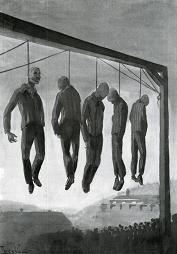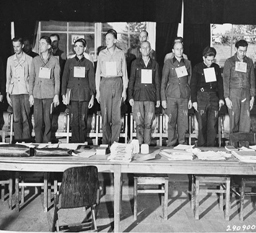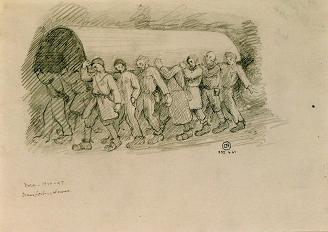Slave Labor
The system of slave labor for V–2 missiles—which first began at the Peenemünde facility in the spring of 1943—expanded dramatically in August 1943 when the production site moved underground at the Kohnstein mountain near Nordhausen. This system reflected the Nazi government’s extensive exploitation of forced labor in its armaments and other industries. By 1944, the Nazis used 7.5 million forced laborers, both Jews and non–Jews, among these over 60,000 at Dora. Dora laborers included political prisoners such as members of the French resistance, Soviet and other eastern POWs, prisoners classified as “asocial,” and some Hungarian Jews who arrived in summer 1944.
Conditions at Dora and its subcamps were horrifying. For over 6 months, more than 10,000 prisoners excavated tunnels using primitive and dangerous techniques. One shift slept in the frigid damp tunnels while another excavated or moved heavy equipment. They had little water and relieved themselves in oil barrels cut in half. Deadly diseases ran rampant. Over 6000 prisoners died or were sent to their deaths in other camps in just 6 months, so many that the SS eventually installed a crematorium. In the months after the factory produced its first V–2s in early 1944, conditions improved somewhat, reflecting the end of the underground construction program and Nazi recognition of the need to reduce death tolls among semi-skilled rocket assembly workers. The exportation of weak and diseased workers to other camps and the completed barracks helped reduce the Dora death toll to 995 for 7 months to November 1945. Yet conditions remained brutal, with diets at starvation levels. Gestapo surveillance intensified, leading to public hangings as punishment for “sabotage.”
By November 1944, horrific suffering returned. Evacuees from camps further east led to massive overcrowding. Wartime disruptions cut food supplies. Changes in SS personnel, with new officers and guards from Auschwitz, increased brutality and public executions. As the death toll reached 5000 between late December 1944 and late March and overwhelmed the crematorium, corpses were burned in open air. Even with defeat inevitable, weapons production continued until late March, after which the SS ordered death marches in which over 3000 prisoners died. On April 11, 1945, the United States Army liberated the remaining prisoners at Dora and in a nearby sub–camp in the city of Nordhausen. US horror at the conditions led to the 1947 Nordhausen Trial of SS guards and “kapos” (prisoners charged with supervising other prisoners). One was sentenced to death, and fourteen received prison sentences.
Life and Death at Mittelbau-Dora
- Conditions at Dora, from “Holocaust Encyclopedia” published by the United States Holocaust Memorial Museum
- Video of US Liberation of Dora, from “Holocaust Encyclopedia” published by the United States Holocaust Memorial Museum
- “Nazi Murder Mills,” April 4th 1945 Newsreel based on Army footage, includes Nordhausen and reference to work on V2s
- Report from US Army War Crimes Investigating Team on “Murder and Maltreatment of Political Prisoners and Prisoners of War in Mittelbeau (Dora) Concentration Camps, near Nordhausen, Germany”
- Information on “Death Marches,” from “Holocaust Encyclopedia” published by the United States Holocaust Memorial Museum
- Information About Music at Dora
- Images of Postcards to and from Dora Prisoners and of Special Money Used at Dora
- Aftermath and War Crimes Trials, from “Holocaust Encyclopedia” published by the United States Holocaust Memorial Museum
Survivor Accounts
- Artwork Created by Prisoner-Survivors
- Video of Survivor Recounting Hanging at Dora, part of “Holocaust Encyclopedia” at United States Holocaust Memorial Museum website
- First Person Narrative by Prisoner and Survivor Michel Depierre
- Biography of Michel Depierre
- First Person Testimony by Alex Baum, Slave Laborer and Survivor of Peenemünde and Dora, interspersed throughout “The Lost Von Braun” documentary by Aron Ranen, posted in four parts to Youtube (link directs to Part One)
- First Person Testimony by Yves Beon, Slave Laborer and Survivor of Dora and Author of the Memoir Planet Dora: A Memoir of the Holocaust and the Birth of the Space Age, as part of National Public Radio Morning Edition Story on Dora from December 3, 1998
- Article from Huntsville Times, November 30, 1999, “V-2 Plant Survivors Publicize Their Story” (halfway down page)
- Poem in French about “The Hell of Dora”




